JUMP TO
TRANSLATE
INTRODUCTION
The story of American women can be told as a series of bursts of activity and reform, and the Progressive Era is one such time. Many of the most active progressive reformers were women, and many of the issues the progressives addressed related directly to the needs and interests of women. Mostly White, upper-middle-class women, many had received a college education and felt obliged to put it to use. About half of these women never married, choosing independence instead.
For women who did not attend college, life was much different. Many single, middle-class women took jobs in the new cities. Clerical jobs opened as typewriters became indispensable to the modern corporation. The telephone service required switchboard operators and the new department stores required sales positions.
For others, life was less glamorous. Wives of immigrants often took extra tenants called boarders into their already crowded tenement homes. By providing food and laundry service at a fee, they generated necessary extra income for the families. Many did domestic work for the middle class to supplement income.
Of all the changes these women Progressives achieved, perhaps none was greater than the right to vote. Long denied to them, women had been fighting for suffrage for over 100 years and the final passage of the 19th Amendment in 1920 was the crowning jewel of their work.
But did women have to win the right to vote in order to make a difference? Was suffrage essential to improve the lives of women?
VICTORIAN VALUES
The 1800s are often referred to as the Victorian Age, named after Queen Victoria of Great Britain who ruled from 1837 to 1901. The time was one of conservative social rules, especially related to women. As was true in much of Europe, Victorian values dominated American social life. The notion of separate spheres of life for men and women was commonplace. The male sphere included wage work and politics, while the female sphere involved childrearing and domestic work. In the United States, historians have dubbed this idea the Cult of Domesticity.
Industrialization and urbanization challenged Victorian values. Men grew weary of toiling tireless hours and yearned for the blossoming leisure opportunities of the age. Women were becoming more educated, but upon graduation found themselves shut out of many professions. Immigrants had never been socialized in the Victorian mindset.
At the vanguard of a social revolt were the young, single, middle-class women who worked in the cities. Attitudes toward sex were loosening in private, yet few were brave enough to discuss the changes publicly.
One exception was Victoria Woodhull. In 1871, she declared the right to love the person of her choice as inalienable. Indeed, she professed the right to free love. She and her sister, Tennessee Claflin, published their beliefs in the periodical Woodhull and Claflin’s Weekly.
Woodhull’s support of free love likely started after she discovered the infidelity of her first husband, Canning. Women who married in the United States during the 1800s were bound into the unions, even if loveless, with few options to escape. Divorce was limited by law and considered socially scandalous. Women who divorced were stigmatized and often ostracized by society. Victoria Woodhull concluded that women should have the choice to leave unbearable marriages.
Woodhull believed in monogamous relationships, although she also said she had the right to change her mind. In her view, the choice to have sex or not was, in every case, the woman’s choice, since this would place her in an equal status to the man, who had the capacity to rape and physically overcome a woman, whereas a woman did not have that capacity with respect to a man.
In 1871, Woodhull declared, “To woman, by nature, belongs the right of sexual determination. When the instinct is aroused in her, then and then only should commerce follow. When woman rises from sexual slavery to sexual freedom, into the ownership and control of her sexual organs, and man is obliged to respect this freedom, then will this instinct become pure and holy; then will woman be raised from the iniquity and morbidness in which she now wallows for existence, and the intensity and glory of her creative functions be increased a hundred-fold…”
In this same speech, Woodhull said of free love, “Yes, I am a Free Lover. I have an inalienable, constitutional and natural right to love whom I may, to love as long or as short a period as I can; to change that love every day if I please, and with that right neither you nor any law you can frame have any right to interfere.”
To be sure, not everyone agreed.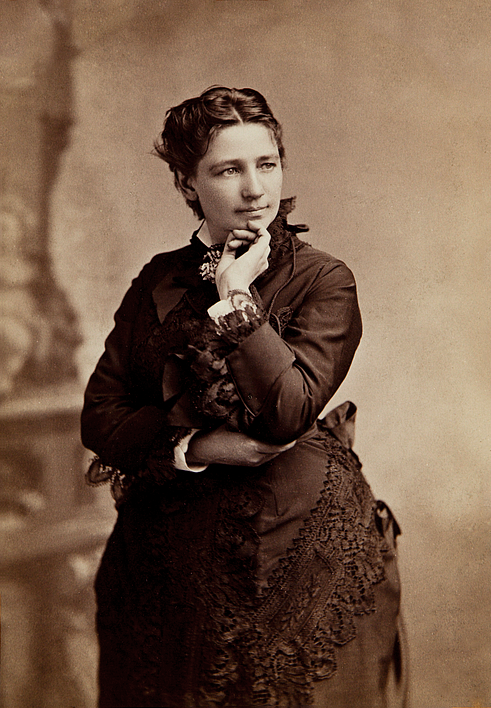 Primary Source: Photograph
Primary Source: Photograph
Victoria Woodhall, Champion of Free Love
Woodhull railed against the hypocrisy of society’s tolerating married men who had mistresses and engaged in other sexual dalliances. In 1872, Woodhull publicly criticized well-known clergyman Henry Ward Beecher for adultery. Beecher was known to have had an affair with his parishioner Elizabeth Tilton, who had confessed to it, and the scandal was covered nationally. Woodhull was prosecuted on obscenity charges for sending accounts of the affair through the mail, and she was briefly jailed.
A devout feminist, Woodhull protested the male hold on politics by running for President in 1872. She became the first female American to do so in a time when women did not even enjoy the right to vote. Her criticisms of Beecher and arrest for obscenity fueled sensational coverage in the media during her campaign. Primary Source: Editorial Cartoon
Primary Source: Editorial Cartoon
“Get thee behind me, Satan!” In this 1872 cartoon by Thomas Nast, a wife carrying a heavy burden of children and a drunk husband, admonishes Satan (Victoria Woodhull), “I’d rather travel the hardest path of matrimony than follow your footsteps.” Mrs. Satan’s sign reads, “Be saved by free love.”
BIRTH CONTROL
For many feminists, legalizing contraception became a central issue in the campaign for equal social and political rights. In the nineteenth century, contraception was often under attack from religious groups, loosely known as the purity movement, which were composed primarily of Protestant moral reformers and middle-class women. This anti-contraception campaign attacked birth control as an immoral practice that promoted prostitution and venereal disease. Anthony Comstock, a postal inspector and leader in the purity movement, successfully lobbied for the passage of the 1873 Comstock Act, a federal law prohibiting the mailing of, “any article or thing designed or intended for the prevention of conception or procuring of abortion,” as well as any form of contraceptive information. Many states also passed similar laws, collectively known as the Comstock laws, that extended the federal law by outlawing the use of contraceptives as well as their distribution. In response, contraception went underground. Drugstores continued to sell condoms as “rubber goods” and cervical caps as “womb supporters.”
At the turn of the century, an energetic movement arose that sought to overturn anti-obscenity laws and the Comstock Acts. Centered in the Greenwich Village neighborhood of New York City, the movement was largely composed of radicals, feminists, anarchists, and atheists such as Ezra Heywood, Moses Harman, D.M. Bennett, Emma Goldman, and Margaret Sanger. In 1913, Sanger worked in New York’s Lower East Side, often with poor women who were suffering severe medical problems due to frequent pregnancies, childbirth and self-induced abortions.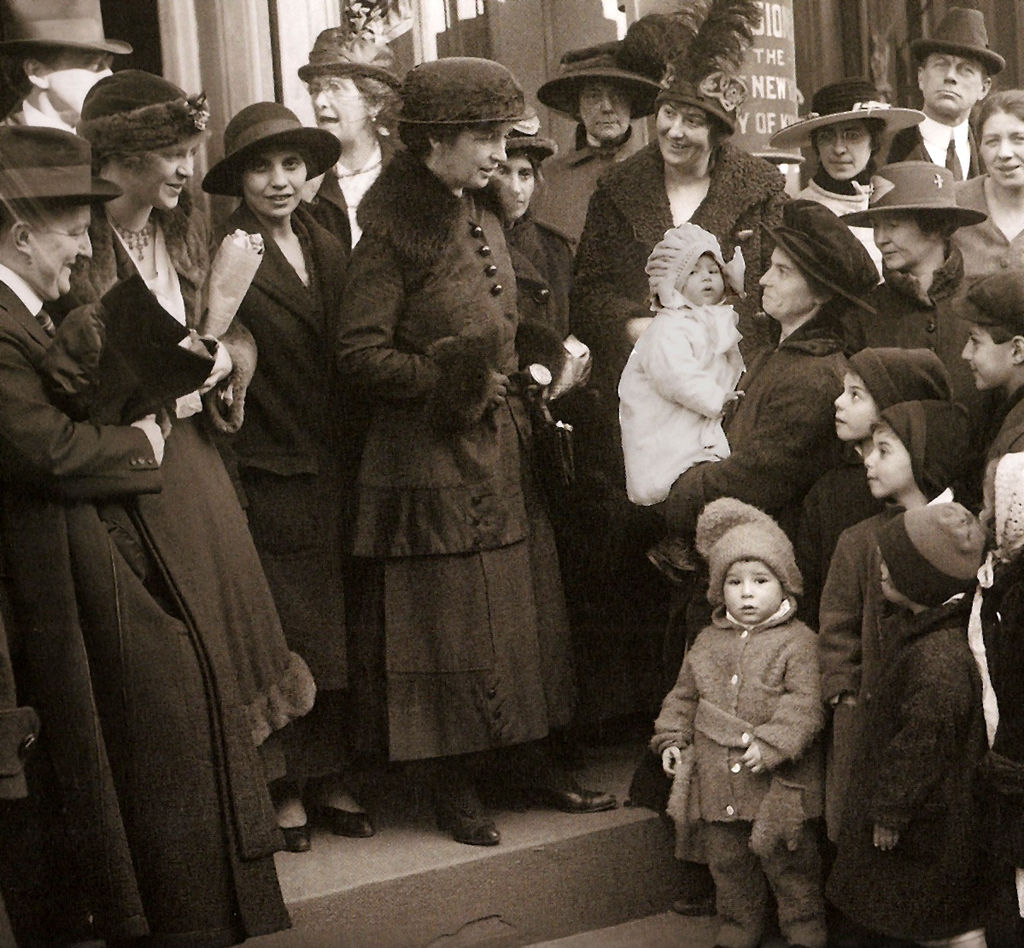 Primary Source: Photograph
Primary Source: Photograph
Margaret Sanger surrounded by her supporters as she exits a New York courthouse after one of her multiple encounters with the anti-contraception legal system.
Under the influence of Goldman and the Free Speech League, Sanger became determined to challenge the Comstock Acts that outlawed the dissemination of contraceptive information. In 1914, she launched The Woman Rebel, an eight-page monthly newsletter that promoted contraception using the slogan, “No Gods, No Masters,” and proclaimed that each woman should be, “the absolute mistress of her own body.” Sanger coined the term birth control, which first appeared in her newsletter. Sanger’s goal of challenging the law was fulfilled when she was indicted in August 1914, but the prosecution focused their attention on articles Sanger had written about marriage, rather than those about contraception. Afraid that she might be sent to prison without an opportunity to argue for birth control in court, Sanger fled to England to escape arrest. While Sanger was in Europe, her husband continued her work, which led to his arrest after he distributed a copy of a birth-control pamphlet to an undercover postal worker.
New York state law prohibited the distribution of contraceptives or even contraceptive information, but Sanger hoped to exploit a provision in the law that permitted doctors to prescribe contraceptives for the prevention of disease. On October 16, 1916, she opened the Brownsville Clinic in Brooklyn. It was an immediate success, with more than 100 women visiting on the first day. A few days after the clinic’s opening, an undercover policewoman purchased a cervical cap at the clinic, and Sanger was arrested. Refusing to walk, Sanger and a coworker were dragged out of the clinic by police officers. The clinic was shut down, and no other birth-control clinics were opened in the United States until the 1920s. However, the publicity from Sanger’s trial generated immense enthusiasm for the cause, and by the end of 1917, there were more than 30 birth-control organizations in the United States.
In the aftermath of Sanger’s trial, the birth-control movement began to grow from its radical, working-class roots into a campaign backed by society women and liberal professionals. Sanger and her fellow advocates toned down their radical rhetoric and emphasized the socioeconomic benefits of birth control, a policy that led to increasing acceptance by mainstream Americans. Media coverage increased, and several silent motion pictures produced in the 1910s featured birth control as a theme. Sanger’s organization grew, changed names, and has developed over time into Planned Parenthood, a nation-wide chain of clinics that provide contraceptive education, women’s health services, as well as abortions.
The birth-control movement received an unexpected political boost during World War I, as hundreds of soldiers were diagnosed with syphilis or gonorrhea while overseas. The military undertook an extensive education campaign, focusing on abstinence, but also offering some contraceptive guidance. Previously, the military did not distribute condoms, or even endorse their use, making the United States the only military force in World War I that did not supply condoms to its troops. When American soldiers were in Europe, they found rubber condoms readily available, and when they returned to America, they continued to use condoms as their preferred method of birth control.
The military’s anti-venereal-disease campaign marked a major turning point for the movement. It was the first time a government institution had engaged in a sustained, public discussion of sexual matters. The government’s public discourse changed sex into a legitimate topic of scientific research, and it transformed contraception from an issue of morals to an issue of public health.
Although Sanger and supporters of birth control were unsuccessful in the early-1900s, their efforts moved the issue forward and made it possible for women’s rights advocates in the 1960s and 1970s to make birth control, especially birth control pills, a legal and acceptable part of American life.
MULLER V. OREGON
In 1909, the Supreme Court decided an important case regarding women in the workplace. The state of Oregon had passed a law limiting the number of hours women were allowed to work outside the home. Legislators at the time believed that women needed to be protected, especially women who were at an age where they might be having and raising young children. Curt Muller, the owner of a laundry business, was put on trial for violating the Oregon law, and convicted of making his female employee work more than ten hours in a single day. Muller was fined $10, but appealed his case all the way to the Supreme Court.
In the case Muller v. Oregon, the Supreme Court found that Oregon’s limit on the working hours of women was constitutional under the 14th Amendment, as it was justified by the strong state interest in protecting women’s health.
The central question of the Muller case was whether women’s freedom to negotiate a contract with an employer should be equal to a man’s. In 1908, gender discrimination was commonplace. The Oregon law was not designed to hurt women, but in the thinking at the time, to protect them, and the Supreme Court decided that the government could enact labor laws that were intended to nurture women’s welfare for the “benefit of all” people did not violate a woman’s right to make contracts.
The case included a few quotes that shed light on societal attitudes about gender roles at the turn of the century. The court wrote, “woman has always been dependent upon man,” and “in the struggle for subsistence she is not an equal competitor with her brother.” And, perhaps most importantly, the case showed that Americans still valued women primarily because of their role as mothers. The court wrote, “her physical structure and a proper discharge of her maternal functions — having in view not merely her own health, but the well-being of the race — justify legislation to protect her from the greed as well as the passion of man… The limitations which this statute places upon her contractual powers, upon her right to agree with her employer as to the time she shall labor, are not imposed solely for her benefit, but also largely for the benefit of all.”
The case divided feminists at the time. Groups like the National Consumer League, which included noted feminists Florence Kelley and Josephine Goldmark, supported the law because it limited working hours for women. However, many equal-rights feminists opposed the ruling, since it allowed laws based on stereotyped gender roles that restricted women’s rights and financial independence. While it provided protection from long hours to white women, it did not extend to women of color, food processors, agricultural workers, and women who worked in white-collar jobs. Although later laws have eroded the Muller decision, women still are not guaranteed equal protection under the Constitution.
SUFFRAGE
Women’s suffrage in the United States was established over the course of several decades, first in various states and localities, sometimes on a limited basis, and then nationally in 1920.
The demand for women’s suffrage began to gather strength in the 1840s, emerging from the broader movement for women’s rights. In 1848, the Seneca Falls Convention, the first women’s rights convention, passed a resolution in favor of women’s suffrage despite opposition from some of its organizers, who believed the idea was too extreme. By the time of the first National Women’s Rights Convention in 1850, however, gaining suffrage was becoming an increasingly important aspect of the movement’s activities.
At the conclusion of the Civil War in 1865, women activists were optimistic about the possibility that they would gain suffrage along with newly freed African Americans. However, activists such as Frederick Douglass and Henry Blackwell argued successfully that the 1860s was the time of the Black male. They feared that linking women’s suffrage to female suffrage would doom passage of the 15th Amendment. Although the leading feminists of the time argued otherwise, the Civil War resulted only in universal male suffrage, a step in the right direction to be sure, but still, half of all Americans remained outside the political process.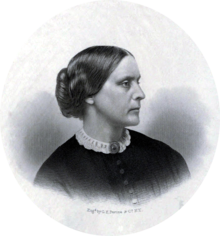 Primary Source: Drawing
Primary Source: Drawing
Susan B. Anthony, one of the first advocates for women’s suffrage. Anthony was instrumental in the movement in the 1800s but passed away before the final push for the ratification of the 19th Amendment.
The first national suffrage organizations were established in 1869 after the disappointment of the 15th Amendment. Susan B. Anthony and Elizabeth Cady Stanton led one group, and Lucy Stone led another. After years of rivalry, the two organizations merged in 1890 and became the National American Woman Suffrage Association (NAWSA) with Anthony as its leading force.
Hoping the Supreme Court would rule that women had a constitutional right to vote, suffragists made several attempts to vote in the early 1870s and then filed lawsuits when they were turned away. Anthony actually succeeded in voting in 1872 but was arrested for that act and found guilty in a widely publicized trial that gave the movement fresh momentum. After the Supreme Court ruled against them in 1875, suffragists began the decades-long campaign for an amendment to the Constitution that would enfranchise women. Much of the movement’s energy, however, went toward working for suffrage on a state-by-state basis.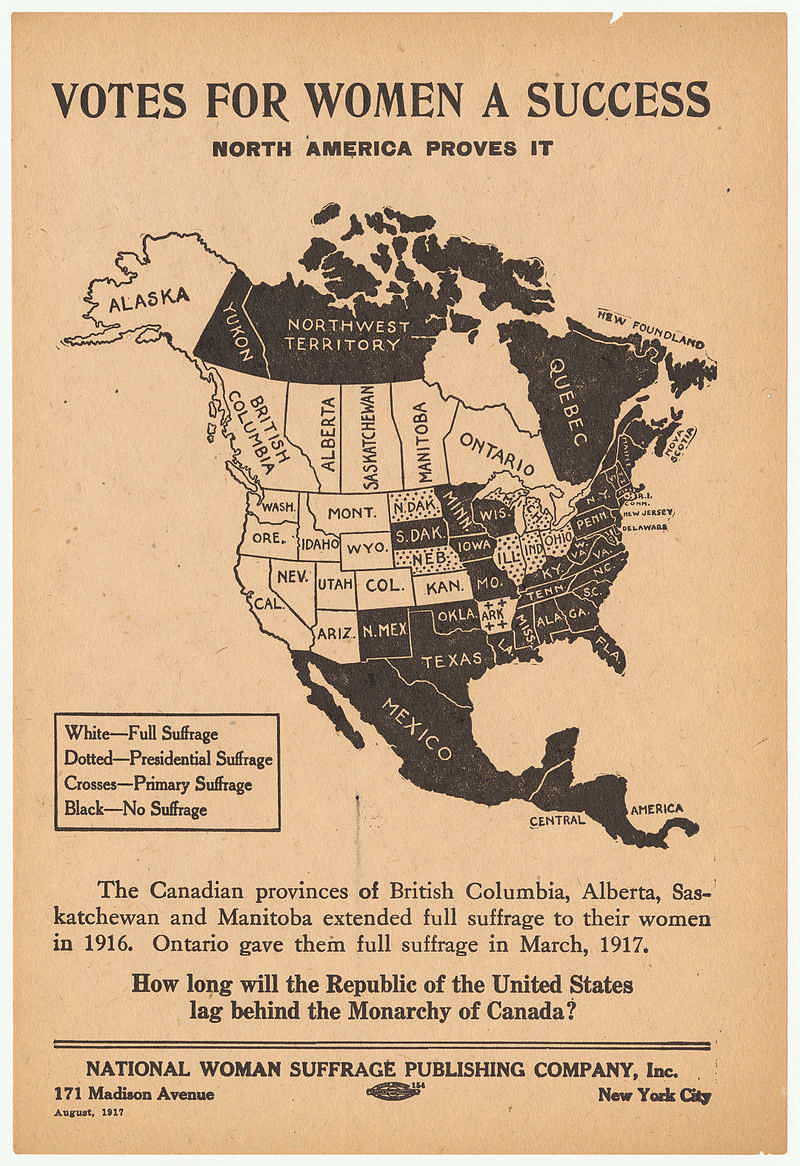 Primary Source: Flyer
Primary Source: Flyer
This map, published by the National Woman Suffrage Publishing Company shows the states that enacted laws granting women’s suffrage as of 1916. The states and Canadian provinces in white allowed full suffrage. Clearly, western states were ahead of the trend.
Progressive reform campaigns strengthened the suffrage movement. Many of its participants saw women’s suffrage as yet another Progressive goal, and they believed that the addition of women to the electorate would help their movement achieve its other goals. In 1912, the Progressive Party endorsed women’s suffrage. The burgeoning Socialist movement also aided the drive for women’s suffrage in some areas.
In 1916, Alice Paul formed the National Woman’s Party (NWP), a militant group focused on the passage of a national suffrage amendment. More than 200 NWP supporters, known as the “Silent Sentinels,” were arrested in 1917 while picketing the White House. Some of the protestors went on a hunger strike and endured forced feeding after being sent to prison. The two-million-member NAWSA, by then under the leadership of Carrie Chapman Catt, also made a national suffrage amendment its top priority.
Brewers and distillers, typically rooted in the German-American community, opposed women’s suffrage, fearing that women voters would favor the prohibition of alcohol. German Lutherans and German Catholics typically opposed prohibition and women’s suffrage. They favored paternalistic families in which the husband decided the family position on public affairs. Their opposition to women’s suffrage was subsequently used as an argument in favor of suffrage when German Americans became pariahs during World War I.
Some other businesses, such as Southern cotton mills, opposed suffrage because they feared that women voters would support the drive to eliminate child labor. Political machines, such as Tammany Hall in New York City, opposed it because they feared that the addition of female voters would dilute the control they had established over groups of male voters.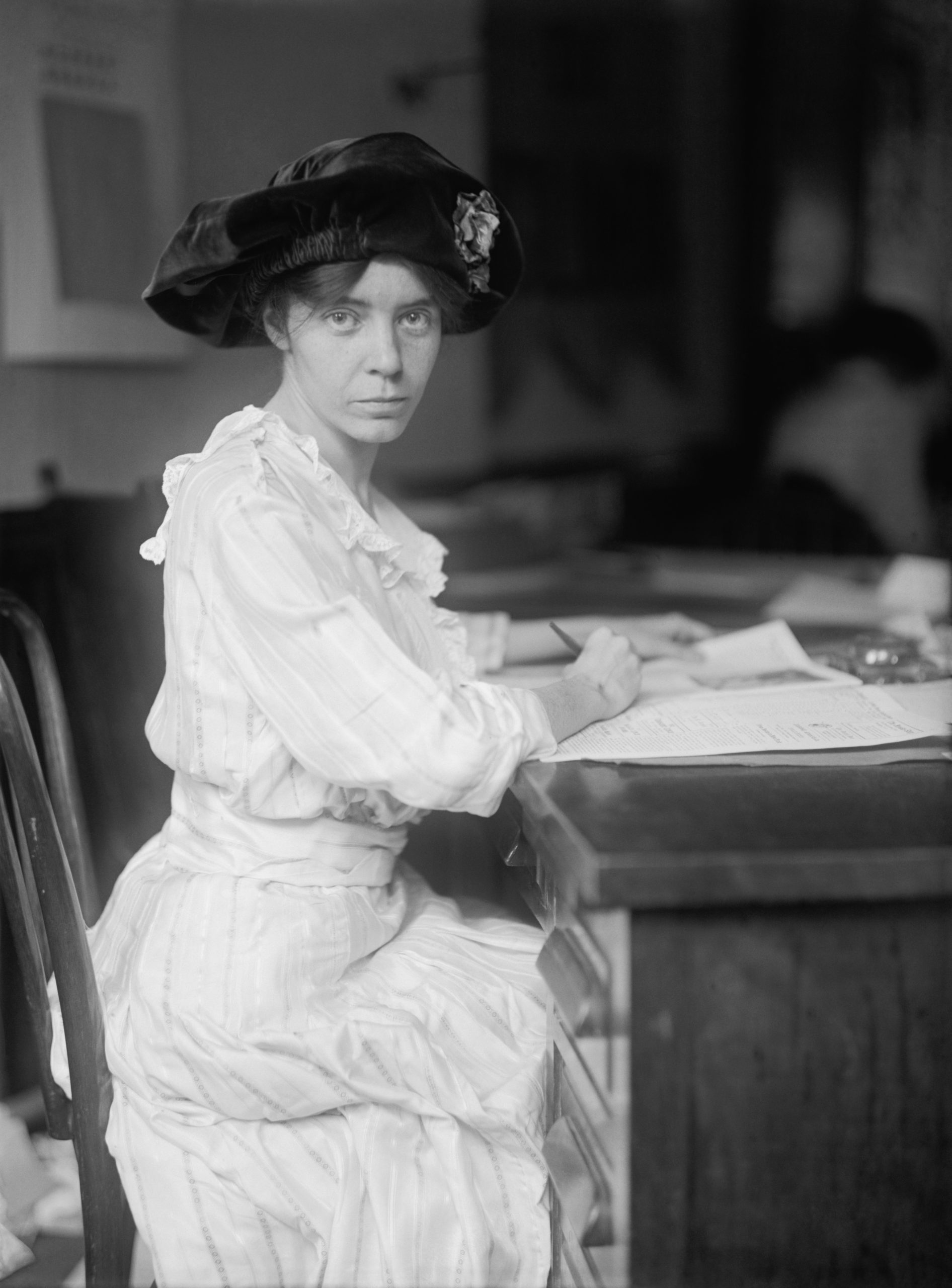 Primary Source: Photograph
Primary Source: Photograph
Alice Paul at the time of the fight for the passage of the 19th Amendment.
Anti-suffrage forces, initially called the “remonstrants,” organized as early as 1870 when the Women’s Anti-Suffrage Association of Washington was formed. Widely known as the “antis,” they eventually created organizations in some 20 states. In 1911, the National Association Opposed to Woman Suffrage was created. It claimed 350,000 members and opposed women’s suffrage, feminism, and socialism. It argued that woman suffrage, “would reduce the special protections and routes of influence available to women, destroy the family, and increase the number of socialist-leaning voters.”
Many upper class women opposed suffrage for women. They had personal access to powerful politicians and feared that having the right to vote themselves would mean surrendering their influence.
Most often the “antis” believed that politics was dirty and that women’s involvement would surrender the moral high ground that women claimed, and that partisanship would disrupt local club work for civic betterment.
Despite opposition, the movement for universal suffrage gained ground, especially in the West. Because states manage elections, individual states began passing laws granting women the right to vote. Many western states, which had recently been settled, were still in the process of establishing traditions. Pioneer women who struggled along the trails west and labored under the sun alongside their husbands, brothers, fathers and sons to tame the soil of the prairie were in no mood to take a back seat to them politically. Eastern states, with hundreds of years of traditional gender divisions were less eager to adopt reformist laws.
Paul, Catt and the advocates for suffrage were persistent however, and after a hard-fought series of votes in Congress and in state legislatures, the 19th Amendment became part of the Constitution in 1920. It reads, “The right of citizens of the United States to vote shall not be denied or abridged by the United States or by any State on account of sex.”
When the Founding Fathers were drafting the Declaration of Independence, Abigail Adams wrote to her husband urging them to “remember the ladies” in their new government. Unfortunately, the Founding Fathers did not, and it took another 144 years and the work of countless women to guarantee both genders the right to vote.
CONCLUSION
The passage of the 19th Amendment has been rightly celebrated throughout history as an important step toward gender equality and the expansion of political equality in America. In a land where “all men are created equal,” it was a chance to include women in that idea.
But suffrage did not radically change the lives of women. The same jobs were available, and the same jobs were closed to women. Nearly 100 years later, women are doing much more in our society, but we have still not elected a women president. Which leads us to our question. Could women have achieved all they did without the right to vote? Could they have opened doors of opportunity in education, health and business if the 19th Amendment had never been ratified?
What do you think? Was suffrage essential to improve the lives of women?
CONTINUE READING
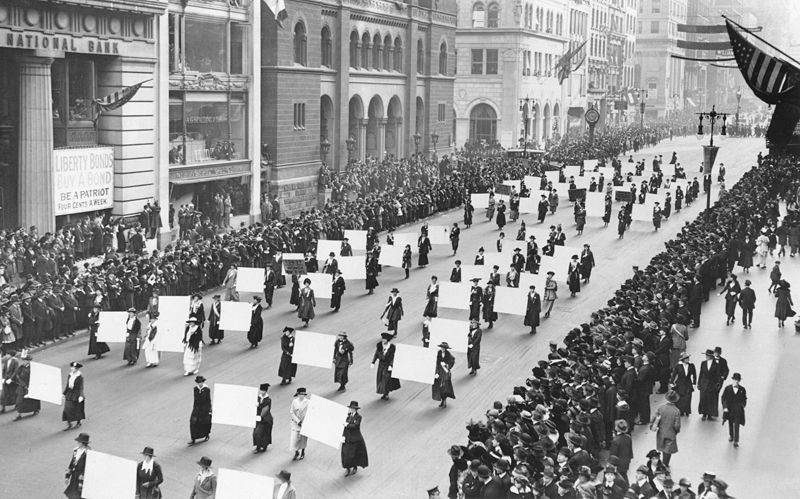
SUMMARY
BIG IDEA: Women had one of their greatest successes in 1920 when the 19th Amendment was ratified, guaranteeing them the right to vote. Women at this time had less success in their efforts to win workplace equality and access to birth control.
During the 1800s, Americans were very conservative about the roles of men and women and especially about how women could behave and dress. In the 1870s, Victoria Woodhull challenged these beliefs. She championed free love, the idea that she could love whoever she wanted and change her mind as much as she wanted. Her ideas were controversial, but she was an important early challenger to social restrictions.
Margaret Sanger believed that women couldn’t be free if they had no control over how many children they would have. She challenged the Comstock Act which prohibited the promotion of birth control. She went to jail multiple times for sending information about birth control through the mail and for opening a birth control clinic in New York City. Her organization grew and is now called Planned Parenthood. Although she wasn’t successfully able to change the law at the time, the government did become concerned about promoting reproductive health during World War I when American troops started contracting STDs. After the war, Americans continued to use condoms they had learned about while in the army.
Women suffered a legal setback in their quest for equality in the Muller v. Oregon Supreme Court Case when the Court ruled that laws that limited the number of hours women could work were constitutional. They reasoned that the primary role women played in society was to be mothers and that allowing women to work as much as they wanted might hurt society.
Women finally won the right to vote in 1920 with the passage of the 19th Amendment. Women had been working for this right since the early 1800s, but Alice Paul and Carrie Chapman Catt succeeded in convincing men in government to approve the amendment. Many western states had already granted women the right to vote in state elections.

VOCABULARY
![]()
PEOPLE AND GROUPS
Victoria Woodhull: Women’s rights advocate in the late 1800s. She was most famously a champion of free love.
Henry Ward Beecher: Famous preacher in the late 1800s in Brooklyn, NY. He had an affair with a married petitioner whose husband sued him. The trial was a nationally publicized public scandal. Victoria Woodhull used the case to argue for free love.
Emma Goldman: Famous socialist activist at the turn of the century. She advocated for labor and women’s rights, but lost credibility due to her connection to the Haymarket Square riot and President McKinley’s assassin.
Margaret Sanger: Champion of birth control in the early 1900s.
Planned Parenthood: Modern organization originally founded by Margaret Sanger. They provide health services and information to women, and most controversially, abortions.
Susan B. Anthony: Early champion of women’s suffrage. She headed the NAWSA. She was honored when a silver dollar coin was minted in 1979 with her likeness.
Elizabeth Cady Stanton: Early champion of women’s suffrage. She cofounded a group with Susan B. Anthony.
Lucy Stone: Early champion of women’s suffrage. Her organization merged with that of Susan B. Anthony and Elizabeth Stanton’s to form the NAWSA.
National American Woman Suffrage Association (NAWSA): Major organization working for women’s suffrage. It was led first by Susan B. Anthony and later by Carrie Chapman Catt.
Alice Paul: Advocate for women’s suffrage in the early 1900s. She founded the National Women’s Party and used more aggressive tactics to publicize the movement.
National Woman’s Party (NWP): Organization founded by Alice Paul in 1916 to work for women’s suffrage. They used more aggressive tactics to spread their message.
Carrie Chapman Catt: Leader of the NAWSA in the early 1900s. She succeeded Susan B. Anthony and saw the ratification of the 19th Amendment.
National Association Opposed to Woman Suffrage: Organization in the early 1900s which fought against the passage of the 19th Amendment.
![]()
KEY IDEAS
Cult of Domesticity: Idea that men should leave home to work and earn money while women stayed at home to cook, clean and raise children. It developed in the early 1800s with the onset of the industrial revolution.
Free Love: The idea that women should be able to love whomever they want for however long they wanted, and change their mind as many times as they wanted. It was championed by Victoria Woodhull in the late 1800s.
Contraception: Any form of birth control.
Birth Control: Any form of contraception. The term was coined by Margaret Sanger.
Suffrage: The right to vote.
![]()
LOCATIONS
Brownsville Clinic: Clinic opened in Brooklyn, NY by Margaret Sanger to provide birth control. It was closed down and Sanger was arrested for violation of the Comstock Act.
![]()
LAWS & COURT CASES
Comstock Act: Law passed in 1873 the prohibited the distribution of birth control and any material promoting birth control. It was used to prosecute Margaret Sanger.
Muller v. Oregon: 1909 Supreme Court case that upheld a law limiting the number of hours women could work outside the home.
19th Amendment: Constitutional amendment ratified in 1920 granting women the right to vote.

What would’ve happened if people like Susan B. Anthony and Elizabeth Cady Stanton didn’t stand up for women’s suffrage?
Did the Comstock act violate the citizen’s freedom of speech?
What kind of influence did the Associations opposed to women suffrage have on people in government and about how they felt on whether or not they should pass the 19th Amendment?
I’m so glad there were women that were brave enough to speak up during this time because I’m scared to see how society would look today of people like Susan B. Anthony did not exist in history.
Were there any men who had a significant part within the advocacy for women’s suffrage?
Is there a certain percentage in where people who opposed to Women’s Suffrage have changed their view and decided to support them instead?
How were self-abortions performed…
It’s been such a long time since birth control and abortions were created and males still can’t mind their own business when it comes to women’s problems.
Was it mostly men or women in the National Association opposed to Woman Suffrage?
How have advancements in the law, like Roe v Wade, helped better the ideals of people from this time period? How do some of these issues that started in the past, still have a lingering effect on women today?
How would transgender women be viewed if they had wanted suffrage along side women, would they have ever made the acception?
What if there was no suffrage, would we not have the 19th Amendment? What if Abigail Adams famous line “remember the ladies” was put into play the day it was given? Would it be necessary for all these protests?
What would society or our world be like if women activists did not try at all?
It’s ironic that even to this day that men still have opinions to make about women’s rights. They try to put a stop to us from voting back then and now they try to stop us from our basic healthcare rights like abortion. It is sad that even after all these years have gone by, women are still being controlled and censored. And when we try to fight back, we are called “angry women.”
How would our society look if the National Association Opposed to Woman Suffrage gained more power than pro-suffragists?
It seems as if our stances on many important issues we face are determined by the situation we are in. Many times even if the issues are immoral or questionable, the way it influences your life shifts when it will benefit/ harm you. I feel as if it has become a race for “fixing” an issue in a way that will help you, rather than doing it for the common good of society as a whole.
Was Frederick Douglass and the others being selfish saying that the 1860’s was for them and not the women?
Why was divorce considered socially scandalous? What about divorce was seen as wrongful doing?
Since women’s suffrage wasn’t included in the 15th Amendment, did this contribute to the racism towards the newly-freed African Americans?
Do you think the idea of Pragmatism is still used today? In my opinion, yes because it is basically where people don’t accept the way of like as it is, but can work for change. People definitely still do that, as you can see multiple protests for different things, such as for the equality of blacks.
Did women’s rights affect the economy?
The suffrage movement gave rise to devout feminists who fought hard to challenge societies’ values about the roles of women. (e.g. Woodhull and her advocacy of free love, Sanger who underwent several arrests for promoting birth control) and thanks to modern-day issues like the wage gap, avid feminists continue to grow — if not, they are more developed than ever. However, this also gives us rise to some radical feminists who go to extreme measures of promoting equal rights and some of them even go far as to taking violent actions of mistreating men. With that in mind, I’m kinda curious if you would say that feminism has gone bad? Or where do you think feminism went wrong?
Have women attained full equality or is there more to be achieved today?
I personally believe that women have not attained full equality. There are many people who will agree with this statement. I feel as if the United States has not done enough when it comes to giving women equal rights with men. In today’s society there is still a fair amount of gender discrimination. But I think that there is still a stigma against women, especially when women face harassment at work. Women should not have to be stigmatized and ostracized in a work environment. This is a reason why women have not attained full equality. Also, there is still debate whether or not women should have a choice in things regarding their own body. In many cases, politics are mostly men and many of the cases or decisions regarding women, are decided by the male majority. I have also found some articles that help support my opinion/point of view.
Links: https://www.pnas.org/content/117/13/6990
https://www.crf-usa.org/bill-of-rights-in-action/bria-20-2-b-have-women-achieved-equality
https://www.pewresearch.org/fact-tank/2020/08/13/key-takeaways-on-americans-views-on-gender-equality-a-century-after-u-s-women-gained-the-right-to-vote/
Some men and women still believe that women deserve more equality and one of the recent arguments is WNBA players should make the same as NBA players. A good amount of people disagree with this argument but this is an example of gender equality nowadays.
It seems that when you look at American history, we are a nation of inequality. We didn’t treat Native Americans equally, we didn’t treat immigrants equally, and we didn’t treat slaves or women equally. This poses the question of, does being a nation of equality actually go against our Nation’s initial beliefs? Is this why we are struggling to achieve equality in America?